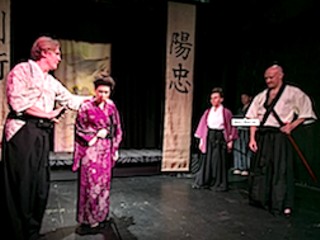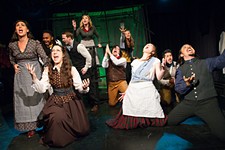Kenjutsu: The Art of the Sword
The Hideout improvises tales of samurai battle and broken honor
By Wayne Alan Brenner, 5:05PM, Fri. Mar. 28, 2014

First, in case you don’t know better already, don’t be thinking of it as “comedy improv,” get it?
Because comedy improv is only one flavor of the artform, and this Kenjutsu series is improv that’s not played for laughs but for the discovery of where it can take the players, the genre, the narrative, and any audience canny enough to come along for the ride.
As the Hideout’s The Black Vault series was to HP Lovecraft … as Gnap! Theatre Projects' Guilds of Steel was to MMORPGs … as the Institution’s The Professor was to Doctor Who … so Kenjutsu: The Art of the Sword is to the samurai-based oeuvre of Akira Kurosawa.
The brainchild of Gnap!’s Shannon McCormick and the Hideout’s Kareem Badr, who also direct the show, this exploration of samurai tropes and tribulations features an ensemble cast of Jeff Britt, Quinn Buckner, Justin Davis, Cat Drago, Brad Hawkins, Marc Majcher, Jordan T. Maxwell, Jayme Ramsay, Audrey Sansom, Lacy Shawn, Ruby Willmann, and that McCormick himself.
If you want to know more about this show, that’s great, because we want to inform you. But to hell with any second-hand reportage: We’ve got, via interview at a local coffeehouse, the lowdown straight from those twin shoguns of the endeavor:
Brenner: Gentlemen, what was the origin of this idea?
Kareem Badr: Well, first of all, we’re both independently fans of the films of Kurosawa – and the genre. And I feel like I remember Shannon mentioning it, kind of offhand, years ago – that samurai improv would be a cool thing that he’d love to do. But it was a way-off-in-the-distance, maybe-one-day thing.
Shannon McCormick: When I first put it out there publically, even though I probably had the idea before, it was in the improv forums, an ask-me-anything. And Jordan Maxwell asked me what genre I’d want to do next. And I said, “Samurai.” And the response to that was, a lot of people were like, “Ooooh, that’d be cool.”
Badr: And then, basically, I talked about it with Roy Janik, just tossing the idea around. And when it came time to make the 2014 schedule for the Hideout’s mainstage, Roy said, “Hey, how about you do the samurai show?” So I poked Shannon, and said, “Do you wanna do this thing?”
McCormick: And I was like, “Yeah, let’s do it.”
Brenner: And when you were casting performers for Kenjutsu, what’d you look for?
McCormick: For any narrative improv show, any ensemble cast, you want a mix of different kinds of things. So what one person brings to the table might be different than what somebody else brings to the table. We wanted to make sure we had some people who were familiar with the genre. That wasn’t a 100% prerequisite, but I don’t think we would’ve wanted to cast the show completely with people who’d never seen a samurai movie before.
Badr: That would’ve made our jobs more difficult.
McCormick: But we have one or two that were unfamiliar with the genre. So it’s a balancing act of familiarity with the genre, sweet improv skills in general, sweet narrative improv skills in particular, physical types, a balance of men and women …
Badr: And an ability to take direction is a big one when I’m auditioning shows. I want to see how people take to a direction, whether they throw themselves at it or second-guess it or, at worst, argue – which is death at any audition, I think.
McCormick: One of the things we did, we wanted to see how gracefully people would lose. Because chances are good that, if you’re playing a samurai, at some point you may have to die.
Brenner: How is it that this cast for a show about samurai, that it’s so ethnically … non-Japanese?
Badr: That’s true.
McCormick: It’s entirely true. And maybe that’s one of the reasons Austin hasn’t seen this show until now, because we were kind of dancing around that for a while.
Badr: The glib answer is, if we had only cast the Japanese improvisers who auditioned, we’d have a cast of zero. And if we had only cast the Asian improvisers who auditioned, we’d have a cast of two – maybe.
McCormick: And that also, in and of itself, makes some glib assessments of “Oh, if you’re of any kind of Asian background, therefore you’re plugged into Japanese culture.” But I think the more complicated answer is, we did wrestle with it, that it would be fair to acknowledge that there’s a certain amount of cultural appropriation going on in the show. But, at the same time, cultural appropriation is kind of how culture works.
Badr: Neither Shannon nor I are Japanese, and we both independently developed an intense love of the films. And – not that the show draws only on Kurosawa, but – Kurosawa himself was influenced by American Westerns, and then he made samurai films, which influenced the second wave of American Westerns. Which is amazing.
McCormick: And one of the things I’m always looking for, and what narrative shows do that maybe other kinds of longform improv shows don’t do, is: Narrative imposes some parameters and rules and modes of thinking that you wouldn’t get to on your own if you were just improvising on your own as a contemporary person. So if you improvise a Dickens show, you’re going to be thinking about things that you wouldn’t be thinking about otherwise, in the way that you approach improv. And it gets you to places that, despite the fact that improv can take you anywhere, you wouldn’t get. And, with the samurai show, there’s so much stuff in here that gets you out of the way you might normally improvise.
Badr: And way before we scheduled the show, years ago, I emailed Doug from Seattle, who was doing improvised Bollywood. And I asked him, “How do you do this?” Because it was a similar thing: It was an all, mostly, white cast. And so how do you do something like that without coming across as racist? Especially something like Bollywood, because it’s already very silly, over-the-top genre. And he was like, “Oh, it’s just like anything else. If you take it seriously and you aren’t doing parody – if you’re treating the genre as just the rules you’re playing within – then that’s fine.” Everything we do at the Hideout, any improvised genre, it’s not parody.
McCormick: It’s not a spoof, we’re not holding up anything for ridicule.
Badr: It’s done with the utmost respect. It’s an homage.
Brenner: And how have the players prepared for this show?
McCormick: We’ve watched a lot of samurai movies together.
Badr: It was a wonderful excuse to have to watch these films.
Brenner: What were the three favorite movies out of all the ones you’ve seen? Not for all time, but that you specifically watched for this show.
McCormick: Ah, Samurai Rebellion.
Badr: Samurai Rebellion was pretty damn sweet. It was really slow – not Kurosawa, but –
McCormick: Hideo Gosha.
Badr: With Toshiro Mifune and, ah – Nakadai, right?
McCormick: Yeah, Tatsuya Nakadai.
Badr: It’s a really slow build-up to twenty minutes of amazing, bloody –
McCormick: Just carnage. But the first three-quarters of it, it’s almost –
Badr: – boring.
McCormick: Yeah, nothing happens, it’s just an elaborate build-up to the final confrontation.
Badr: But a really good study in Japanese culture of that time, actually. But, unless you’re looking at it with that eye, I can see how it would be boring.
McCormick: We watched, just the other night, a more contemporary one called When the Last Sword is Drawn, from 2007. And it was really good, and had a note of comedy in it that we hadn’t seen in the older samurai movies.
Badr: Like, the lead was shamelessly greedy. Anytime somebody would offer money, there was this running bit. Anytime he’d be offered money as a retainer or whatever –
McCormick: – he’d want to know about the money, how much was he going to get –
Badr: – could he get more money, could he get the money now –
McCormick: It was definitely played for laughs. And that was good for us to see, to know that we could be completely true to the genre and still have it be funny.
Badr: There were so many that we watched, but Sword of Doom was another one that stuck out. It’s another one with Mifune and Nakadai.
McCormick: The other thing we did to prepare, we took an Aikido class together, a crash course to learn some basics of swordwork.
Badr: As we were approaching the show, I realized that, OK, we’re not going to do full-speed fighting, and we’re not going to be swordmasters, but we need some familiarity with how to hold a sword, basic stances and positions. And I was wracking my brain about how to do this, and I realized that the only reason I know any of the lingo, the fact that the wooden sword is called a bokken, was that I took a martial-arts weaponry and conditioning class 14 years ago at ACC. So I contacted the instructor, who’s a really cool guy, and I said, "Here’s the deal: We’re doing a really cool show, and I’d love for the cast to train with you for a bit, like a one-day crash course, would you be interested in that?” And his response was, “I just quit my day job so I can dedicate more time to artistic projects, so yes.”
Brenner: Who is this guy?
Badr: His name is Mark Leidig. He teaches at ACC Northridge and he’s been studying Aikido for 40 years. He’s serious.
McCormick: He’s the real deal. Studied with Japanese guys, definitely an accomplished martial artist. And we all met at the park in Mueller, and were the object of many stares.
Brenner: LARPing!
McCormick: Yeah – 14 adults with bokken, standing in a field, practicing sword moves.
Badr: It was so cool, though. The fact that he was so open to doing it was just delightful – and exactly what we needed, because he also focuses on the philosophical side of it. And I was always amused, as a student, by his rambling, because he thinks and breathes the stuff and ties everything into it. Because that’s what he does. I mean, whenever you’re dedicated to something, you find ways to draw parallels.
McCormick: It was almost as if Brenner had taught the class. Because there were all these metaphors about jazz, and quantum physics, and botany, and several other things.
Badr: Yeah, we’d just learned some swordwork and he was talking about jazz. And I thought, “Well, Shannon’s happy.”
McCormick: Yeah, I dug it.
Badr: Yeah, so it’s not like we’re wonderfully great, but we’re at least proficient, we’ve learned enough of the basics so we, uh, can fake it.
McCormick: So we look convincing.
Brenner: OK, but so an audience coming to see this, what can they expect not to see? That you think they might expect to see?
Badr: They can be guaranteed they won’t see anyone doing Pidgin English-Japanese.
McCormick: Or bad Japanese accents.
Badr: That’s not gonna happen at all. If it did, I’d probably take the cast member and beat them after the show. That was one of the specific things: Just get it out of your head, it’s not gonna happen. Because it doesn’t need to, because that sells it short.
McCormick: I know that, for some people, they kind of lump all martial arts together. But this isn’t like Bruce Lee, like a contemporary Kung Fu movie. It’s not a Wushu, Shaw Brothers, Hong Kong martial-arts film: there’s nothing like wirework or constant hand-to-hand combat. What it is, it’s a lot of tension, built around maybe one or two decisive sword battles.
Badr: That’s another thing to mention: The sword fighting is not what you’d expect from typical Western films, where there’s a lot of parrying and, you know, fencing through the castle and cutting down the chandelier. In this style of sword fighting, the swords almost never cross. It’s sort of just nothing-nothing-nothing, then strike.
McCormick: And somebody’s dead.
Badr: And somebody’s dead.
A note to readers: Bold and uncensored, The Austin Chronicle has been Austin’s independent news source for over 40 years, expressing the community’s political and environmental concerns and supporting its active cultural scene. Now more than ever, we need your support to continue supplying Austin with independent, free press. If real news is important to you, please consider making a donation of $5, $10 or whatever you can afford, to help keep our journalism on stands.
Trey Gutierrez, Feb. 8, 2019
Wayne Alan Brenner, Sept. 7, 2020
Wayne Alan Brenner, Dec. 14, 2017
March 22, 2024
March 22, 2024
The Hideout Theatre, Shannon McCormick, Kenjutsu, Art of the Sword, improv, Kareem Badr, Akira Kurosawa, samurai











